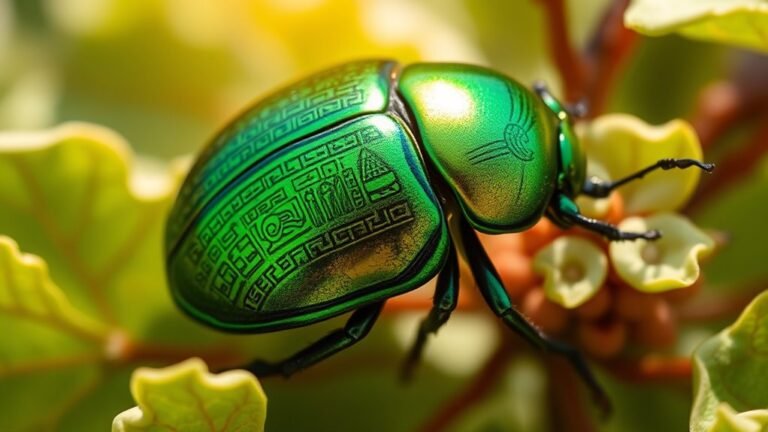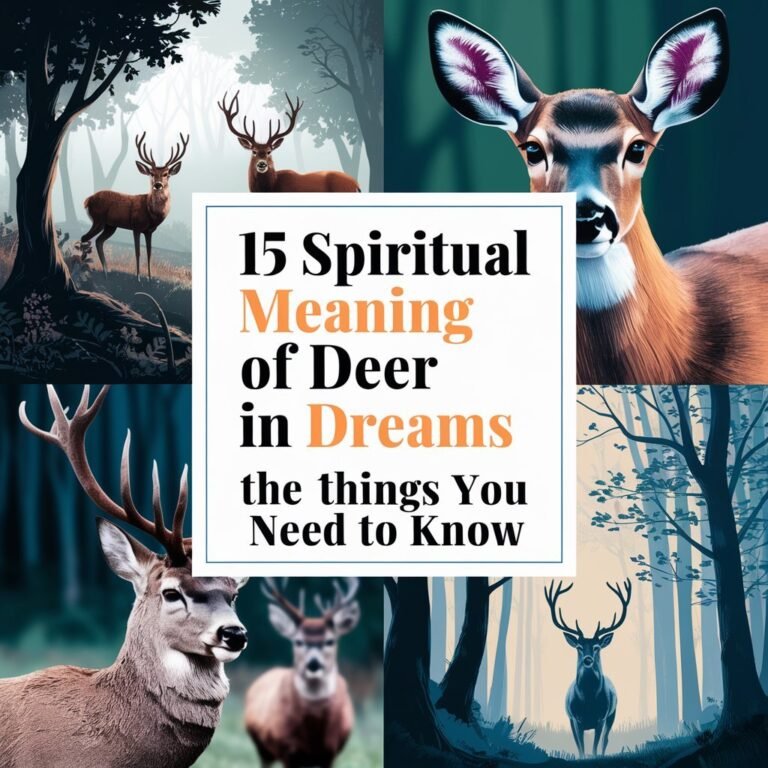11 Spiritual Meanings of a Death’s Head Moth
As we explore the 11 spiritual meanings of the Death's Head Moth, we can't help but appreciate its powerful symbolism connected to transformation and introspection. This intriguing creature challenges us to reflect on our mortality and encourages a deeper understanding of life's impermanence. With its striking appearance, it serves as a reminder of the delicate balance between darkness and light. But what does it truly mean for our personal journeys? Let's uncover the layers of meaning behind this enigmatic moth and see how it can resonate with our own experiences.
Key Takeaways
- The Death's Head Moth symbolizes transformation, representing personal growth through shedding old identities and embracing change.
- Its skull pattern invokes reflection on mortality, enhancing appreciation for life and connections with others.
- This moth encourages spiritual awakening, urging exploration of inner truths and confronting fears for enlightenment.
- It embodies hidden knowledge, teaching the importance of safeguarding personal secrets while trusting intuition in relationships.
- As a messenger from the afterlife, it fosters connections with departed loved ones, promoting comfort and spiritual communication.
Symbol of Transformation
The Death's Head Moth embodies a powerful symbol of transformation, reflecting the profound changes we all encounter in our lives. As we navigate our own metamorphic journey, we can draw inspiration from this remarkable creature. Its striking appearance, marked by the skull-like pattern on its back, serves as a reminder of the beauty that can arise from darkness.
We often experience moments that challenge us, pushing us to evolve and grow. The Death's Head Moth captures this idea perfectly, showcasing the transformative energy within struggle. When we embrace our challenges, we allow ourselves to emerge stronger and more resilient.
This moth's life cycle—from caterpillar to chrysalis, then to its stunning adult form—mirrors our own processes of change. Just like the moth, we can shed our old selves, embracing the unknown as an opportunity for growth.
Each time we face adversity, we can choose to see it as a stepping stone towards our next transformation. In recognizing the Death's Head Moth as a symbol of transformation, we foster a sense of belonging in the shared human experience of change, reminding us that we're never alone on our journey.
Connection to Mortality
Recognizing the Death's Head Moth's striking skull pattern invites us to confront our own mortality and the inevitability of death. This enthralling creature embodies the cycle of life, reminding us that every beginning has an end. As we observe its journey—from caterpillar to chrysalis and ultimately to moth—we're encouraged to reflect on our own life cycles. Each stage is fleeting, urging us to appreciate the present moment.
In this shared experience of existence, we develop an existential awareness that binds us together. We all face the same ultimate fate, and in acknowledging this, we find a sense of belonging. The Death's Head Moth serves as a poignant reminder that while life is transient, it's precisely this impermanence that enhances our appreciation for what we have.
In embracing our mortality, we can cultivate deeper connections with one another and the world around us. The moth's haunting beauty compels us to explore the depths of our fears and desires, pushing us to live more authentically.
Together, let's honor the lessons this remarkable creature imparts, as we navigate our own paths through the intricate tapestry of life and death.
Emblem of Rebirth
Death's Head Moth's symbolism extends beyond mortality, embodying the profound theme of rebirth. When we explore its connection to transformative journeys, we uncover a deeper understanding of life's cyclical nature. This remarkable creature reminds us that endings often pave the way for new beginnings, a concept celebrated in various rebirth rituals across cultures.
In our own lives, we face moments that challenge us to shed old identities, much like the moth emerging from its cocoon. These transformative journeys can be intimidating, yet they offer us a chance to embrace change and renewal.
The Death's Head Moth encourages us to acknowledge our struggles and recognize that they serve as catalysts for growth. As we engage in our personal rebirth rituals, whether through meditation, intention-setting, or creative expression, we can draw inspiration from this enigmatic moth.
It symbolizes resilience, urging us to rise from the ashes of our past selves. Together, let's celebrate the beauty of transformation, knowing that just as the Death's Head Moth emerges anew, so too can we embrace the endless possibilities that lie ahead.
Messenger From the Afterlife
Amidst the shadows of our existence, the Death's Head Moth often emerges as a powerful messenger from the afterlife, bridging the gap between the living and the departed. This striking creature carries deep symbolism, reminding us of the ongoing connection we share with those who've crossed over.
When we encounter this moth, we might feel a sense of comfort, as if the veil between worlds has thinned, allowing for spiritual communication to unfold.
As we explore its significance, we notice that the Death's Head Moth serves as a beacon of afterlife messages. Its presence can evoke memories of lost loved ones, inviting us to reflect on the lessons and love they imparted.
In many cultures, the moth is viewed as a guide, signaling that our departed companions are watching over us, offering support during difficult times.
Through its haunting beauty, the Death's Head Moth encourages us to remain open to signs and synchronicities from the other side. It reminds us that, while life may be fleeting, the bonds we forge transcend physical existence, fostering a sense of belonging that endures even beyond death.
Representation of Change
When we observe the Death's Head Moth, it becomes clear that this enigmatic creature embodies transformation and change. Its life cycle is a profound metaphor for our own metamorphic journey, reminding us that personal evolution often requires embracing discomfort and uncertainty.
The moth's striking appearance, featuring a skull-like marking, symbolizes the duality of life and death, illustrating that change is a constant process intertwined with acceptance.
In this spirit, we encourage reflection on our own paths of transformation. Consider the feelings that arise during times of change:
- The thrill of new beginnings
- The fear of the unknown
- The joy found in self-discovery
- The pain of letting go
- The strength gained through adversity
These emotions remind us that each stage of growth is essential in shaping who we are.
As the Death's Head Moth navigates the darkness, it teaches us to trust in our own ability to emerge, no matter how challenging the journey may feel. Together, we can embrace the beauty of change, recognizing that every experience contributes to our unique tapestry of existence.
Guardian of Secrets
The Death's Head Moth's mystique extends beyond its transformative nature; it also serves as a guardian of secrets, shrouded in layers of symbolism and meaning. As we explore its role as a mystical guardian, we uncover the rich tapestry of hidden knowledge it embodies. This remarkable creature invites us to investigate the enigmatic aspects of our own lives, encouraging us to embrace the mysteries that often lie just beneath the surface.
When we encounter a Death's Head Moth, we're reminded of the importance of safeguarding our personal truths. It symbolizes the delicate balance between revealing and concealing, teaching us that not all knowledge is meant to be shared. This moth embodies the wisdom of knowing when to listen and when to speak, urging us to trust our intuition in traversing the complexities of our relationships.
As we seek belonging, we grow aware of our own hidden depths. The Death's Head Moth whispers to us, reminding us that each secret we hold can transform into a source of strength.
In recognizing its guardianship, we open ourselves to a deeper understanding of ourselves and others, fostering connections that honor both vulnerability and strength.
Sign of Protection
In the shadows of our everyday lives, the Death's Head Moth emerges not just as a symbol of transformation but also as a powerful sign of protection. This remarkable creature embodies protective energy that resonates deeply within us, reminding us that we're never truly alone.
The Death's Head Moth serves as our spiritual guardian, guiding us through the complexities of life while shielding us from harm.
As we contemplate this intriguing moth, we can appreciate the layers of meaning it brings to our lives:
- It encourages us to embrace our vulnerabilities.
- It symbolizes the strength we gain from overcoming adversity.
- It reassures us of the presence of unseen forces watching over us.
- It teaches us to trust our instincts while maneuvering through challenges.
- It connects us to a larger spiritual community that fosters belonging.
Indicator of Spiritual Awakening
Emerging from the depths of our subconscious, the Death's Head Moth often signals a profound spiritual awakening. When we encounter this intriguing creature, it can feel like a call to investigate the uncharted territories of our souls. The symbolism it carries nudges us towards significant personal growth, encouraging us to confront our fears and embrace change.
As we probe deeper into our inner selves, we may find that the Death's Head Moth serves as a guide, illuminating the path to enlightenment. Its unique appearance reminds us that beauty can arise from the shadows, and so too can our spiritual growth flourish when we face our inner darkness.
This moth invites us to reassess our beliefs, urging us to shed outdated patterns and embrace new perspectives. In recognizing the Death's Head Moth as an indicator of spiritual awakening, we can foster a sense of community among those on similar journeys.
Together, we can celebrate our personal awakenings, sharing insights and experiences that strengthen our bonds. Ultimately, this moth encourages us to embrace the transformative power of spiritual exploration, fostering a deeper connection with ourselves and each other.
Reflection of Inner Strength
While we navigate our spiritual journeys, the Death's Head Moth stands as a powerful reflection of our inner strength. This enigmatic creature embodies the essence of inner resilience and personal fortitude, reminding us that true power often lies hidden beneath the surface.
As we observe its striking appearance and remarkable adaptability, we can draw inspiration from its journey through transformation and survival.
Consider the following aspects that resonate deeply with our experiences:
- Embracing change: Just as the moth evolves, we too can adapt to life's challenges.
- Finding beauty in darkness: The moth thrives in shadowy environments, teaching us to discover light in our struggles.
- Overcoming fears: Its eerie presence invites us to confront our own insecurities and doubts.
- Breaking free from constraints: The moth's flight signifies liberation from the limitations we often impose on ourselves.
- Reclaiming our power: By recognizing our inner strength, we can take charge of our destinies.
As we reflect on these connections, we reaffirm our shared journey toward greater resilience and empowerment, celebrating the strength we cultivate within ourselves.
Catalyst for Introspection
Through the haunting allure of the Death's Head Moth, we find a powerful catalyst for introspection. This remarkable creature invites us to set forth on a self-discovery journey, urging us to confront the deeper aspects of our existence. Its striking appearance, often associated with transformation and mystery, reflects our own hidden layers waiting to be explored.
As we observe the moth, we're reminded of the importance of personal reflection. In a world that often values distraction over contemplation, the Death's Head Moth beckons us to pause and look inward. It challenges us to unearth our fears, desires, and unresolved questions, revealing the shadows that linger within our souls.
This journey isn't merely about acknowledging discomfort; it's about embracing it as an integral part of our growth. By engaging with the symbolism of the Death's Head Moth, we cultivate a deeper understanding of ourselves.
This introspective process fosters connection—not just with our inner selves but also with others who share similar paths of exploration. Ultimately, the Death's Head Moth becomes a guide, leading us toward a richer, more authentic existence through the power of reflection.
Allure of the Unknown
The enigmatic presence of the Death's Head Moth captivates our imagination, drawing us into the depths of the unknown. Its striking appearance, with a skull-like pattern on its back, evokes a sense of mystical attraction that invites us to explore shadowy mysteries.
We find ourselves pondering questions about life, death, and the unseen forces that shape our existence. As we probe deeper, we discover the allure this moth holds over us:
- It represents the shift between life and death.
- It symbolizes the beauty that can emerge from darkness.
- It ignites our curiosity about what lies beyond the veil of the ordinary.
- It encourages us to embrace the uncertainties that life presents.
- It reminds us that every ending is a new beginning.
In these reflections, we forge a connection with the Death's Head Moth, recognizing our shared fascination with the unknown. By embracing its symbolism, we find a sense of belonging in our collective quest for understanding.
The moth whispers to us, inviting us to confront our fears and to seek wisdom in the mysteries that surround us, revealing the profound beauty hidden within the shadows.
Frequently Asked Questions
What Cultures Have Historically Revered the Death's Head Moth?
Throughout history, we've seen cultures like Ancient Egypt and Mexican folklore revering the death's head moth, symbolizing transformation and the connection between life and death, inviting us to explore deeper meanings within our own lives.
How Does the Death's Head Moth Appear in Literature?
In literature, we often see the death's head moth as a powerful symbol, representing transformation and mortality. Its character representation evokes deep emotions, reminding us of our own journeys through fear, change, and ultimately, acceptance.
Are There Any Superstitions Associated With the Death's Head Moth?
We've often encountered various folklore beliefs linking moth symbolism to omens of change or loss. In many cultures, spotting a death's head moth stirs superstitions about impending events, sparking our curiosity about its deeper meanings.
What Is the Scientific Significance of the Death's Head Moth?
The death's head moth showcases fascinating moth anatomy, revealing its unique adaptations. Its ecological role includes pollination and serving as a food source, highlighting how interconnected we all are in maintaining our environment's delicate balance.
How Can One Interpret a Death's Head Moth Encounter Spiritually?
When we encounter a death's head moth, we can explore its spiritual symbolism, embracing our personal transformation. This encounter invites us to reflect on change, resilience, and the profound journey of our inner selves.

Liza Stockholm is an esteemed spiritual guide and the visionary behind Spiritual with Liza. With a profound passion for empowering others on their spiritual journey, Liza offers a blend of educational content and personal guidance. Her expertise in spirituality is rooted in years of dedicated practice and study, making her a trusted companion for those seeking enlightenment and inner peace.






